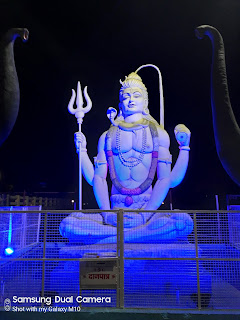Vashishtha Head
The Vedic Aryan Head -
In 1990, the scholars of Indian history were thrilled with an article published in the Journal of Indo European Studies (vol18, page 425-446). The article was "Analysis of an Indo-Europian Vedic Aryan Head- 4500-2500 BC" by Hicks and Anderson.
Image courtesy: Ramani's blog
This antique Aryan head was recovered in New Delhi by Dr. P Anderson from a scrap dealer in 1958. There was tilak markings on the brow and handlebar moustaches on this copper based Aryan's head. The hair was styled in a manner described for Rigvedic Vashishtha- coiled with a tuft to the right.
Tests for dating of the artifact were performed by three different universities using different techniques. MASCA corrected carbon dating produced a date centered around 3700 BC +,- 800 years. Anderson claimed that the carbon dating was done by very advanced technique in Zurich by Laboratory for Nuclear Science at the Swiss Federal Institute of Technology. Dating was also performed through the use of cyclotron at University of California, and Dabis ion probe and Van de Graaf linear accelerator at Stanford University. Spectographic analysis, X ray dispersal analysis and metallography tests were performed.
Controversy-
Hicks and Anderson were firm with their claim. But the historians neglected their claim saying that the head was not recovered from any archeological site in situ. It was recovered from a scrap dealer. Besides it, the word Narayan was inscribed on it, which was incised later on according to Hicks and Anderson. Many historians claimed that it might be recasted from prehistoric copper items.
The Dating Techniques of Copper Items-
Metallography is the study of structure of metals and metal alloys through examination of specimens with a metallurgical microscope.X ray dispersal analysis is a non destructive method of analytic chemistry. When copper is exposed to air, a layer of cuprite (Cu2O) is formed on its surface which is converted to tenorite (CuO) with time. Examination of copper artifacts using scanning electron microscopy coupled with X ray spectroscopy confirms the presence of cuprite and tenorite. With the ratio of cuprite and tenorite, and help of calibration curve, we can estimate the age of copper artifacts.
Who was Vashishtha?
Vashishtha is a Rigvedic sage and known as chief priest of Ikshwaku dynasty. He is one of the saptarishis. Mandal 7 of Rigveda is created by him.
According to Rigveda (7:33:11), he was son of vedic god Mitravarun and apsara Urvashi. He crossed the river Sindhu and helped the vedic king Sudas in the battle of ten kings and became the chief priest of Bharats. He was married to Arundhati.
Views-
In my view, if it was recasted from old copper items, how is it possible the remains of carbon, cuprite and tenorite on the surface of a recasted copper item? As all of these should be destroyed during melting.










Thanks for sharing such informative blog. We are proud to offer the UK’s most affordable direct cremation service in York. Direct cremation, which is a cremation without a funeral service is becoming a more popular way for families in the UK to say goodbye to their loved ones in a more personal, private and affordable way.
ReplyDeleteDirect Cremation
Thanks for sharing such informative Blog. Direct Cremation Visit our site.
ReplyDeleteWhere is it now
ReplyDeleteSame I wanna know where it is right now as well
Delete